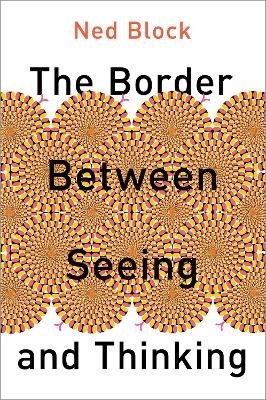
The Border Between Seeing and Thinking
Oxford University Press Inc (Verlag)
978-0-19-762222-3 (ISBN)
Philosopher Ned Block argues in this book that there is a "joint in nature" between perception and cognition and that by exploring the nature of that joint, one can solve mysteries of the mind. The first half of the book introduces a methodology for discovering what the fundamental differences are between cognition and perception and then applies that methodology to isolate how perception and cognition differ in format and content. The second half draws consequences for theories of consciousness, using results of the first half to argue against cognitive theories of consciousness that focus on prefrontal cortex. Along the way, Block tackles questions such as: Is perception conceptual and propositional? Is perception iconic or more akin to language in being discursive? What is the difference between the format and content of perception, and do perception and cognition have different formats? Is perception probabilistic, and if so, why are we not normally aware of this probabilistic nature of perception? Are the basic features of mind known as "core cognition" a third category in between perception and cognition? This book explores these questions not by appeals to "intuitions," as is common in philosophy, but to empirical evidence, including experiments in neuroscience and psychology.
This is an open access publication, available online and distributed under the terms of the Creative Commons Attribution-Non Commercial-No Derivatives 4.0 International licence (CC BY-NC-ND 4.0), a copy of which is available at http://creativecommons.org/licenses/by-nc-nd/4.0/. Enquiries concerning use outside the scope of the licence terms should be sent to the Rights Department, Oxford University Press.
Ned Block is Silver Professor in the Departments of Philosophy and Psychology and the Center for Neural Science at New York University. He has given the John Locke Lectures at Oxford, the Immanuel Kant Lectures at Stanford, the William James Lectures at Harvard, the Josiah Royce Lectures at Brown, the Thalheimer Lectures at Johns Hopkins, and the Jean Nicod Lectures at Ecole Normale Superieure, Paris.
Preface
1. Introduction
-Consciousness
-Pure Perception
-What is a joint?
-Constitutivity vs explanatory depth
-The contents of perception
-Realism about perceptual and cognitive representation
-Three-layer methodology
-Higher "capacity" in perception (whether conscious or not) than cognition
-Fragile visual short term memory
-Slot vs pool models
-Armchair approaches to the perception/cognition border
-Conceptual engineering
-Perceptual learning
-Superimposition of Imagery on Perception
-Cognitive states that use perceptual materials
-Dual component views
-Interface of perception with cognition
-Implications outside philosophy of mind
-Roadmap
2. Markers of the perceptual and the cognitive
-Adaptation
-Perception vs cognition in Language
-Different kinds of adaptation
-Visual hierarchy
-The use of adaptation in distinguishing low-level from high-level perception
-The use of adaptation in distinguishing perception from cognition
-Semantic satiation
-Rivalry
-Pop-out
-Interpolation of Illusory Contours
-Neural markers of perception and cognition
-Other markers of perception
-Phenomenology
-Summary
3. Two kinds of seeing-as and singular content
-Burge and Schellenberg on Singular Content
-Attribution and Discrimination
-Ordinary vs technical language
-Bias: perception vs perceptual judgment
-Evaluative perception
4. Perception is constitutively non-propositional and non-conceptual
-Concepts and propositions
-The non-propositional nature of perception
-Conjunction
-Negation
-Atomic propositional representations
-Rivalry and propositional perception
-How do iconicity, non-conceptuality and non-propositionality fit together?
-Laws of appearance
-Bayesian "inference"
-Bayesian realism
5. Perception is iconic; cognition is discursive
-Iconicity, format and function
-Iconicity and determinacy
-Structure
-Analog tracking and mirroring
-Analog magnitude representations
-Mental imagery
-Holism
-Integral vs Separable
-Iconic object-representations in perception
-Object files in working memory
-Memory involving perceptual representations
-Iconic memory
-Fragile visual short term memory
-Working memory
-Arguments against perceptual iconicity that are based on perception and memory of objects
6. Non-conceptual color perception
-Perceptual category representations
-Infant color categories
-Color Constancy
-Infants' failure to normally deploy color concepts
-Working memory again
-Experiments on babies' working memory representations
-Conceptual perceptual states
-Concepts and Consciousness
-Systematicity again
-Modality
7. Neural evidence that perception is non-conceptual
-"No-report" paradigm vs. "no-cognition" paradigm
-Another "no-report" paradigm
8. Evidence that is wrongly taken to show that perception is conceptual
-Fast perception
-Cognitive access to mid-level vision
9. Cognitive penetration is common but does not challenge the joint
-Cognitive impenetrability: Recent History
-Ambiguous stimuli
-Spatial attention
-Feature-based attention
-Dimension Restriction
-Mental Imagery
10. Top-down effects that are probably not cases of cognitive penetration
-Figure/ground
-Memory color
11. Modularity
12. Core cognition and perceptual analogs of concepts
-Perception of causation
-Core Cognition
13. Consciousness
-Phenomenal consciousness vs. access consciousness
-Global Workspace
-Higher Order Thought
-Alleged evidence for higher order thought theories of consciousness
-Prefrontalism and electrical stimulation of the brain
-Overflow
-Biological reductionism
-Direct awareness
-Teleological approaches
-Fading qualia
-Consciousness and free will
14. Conclusions
Bibliography
| Erscheinungsdatum | 14.11.2022 |
|---|---|
| Reihe/Serie | PHILOSOPHY OF MIND SERIES |
| Verlagsort | New York |
| Sprache | englisch |
| Maße | 242 x 162 mm |
| Gewicht | 921 g |
| Themenwelt | Geisteswissenschaften ► Philosophie |
| Geisteswissenschaften ► Psychologie ► Allgemeine Psychologie | |
| ISBN-10 | 0-19-762222-4 / 0197622224 |
| ISBN-13 | 978-0-19-762222-3 / 9780197622223 |
| Zustand | Neuware |
| Haben Sie eine Frage zum Produkt? |
aus dem Bereich


